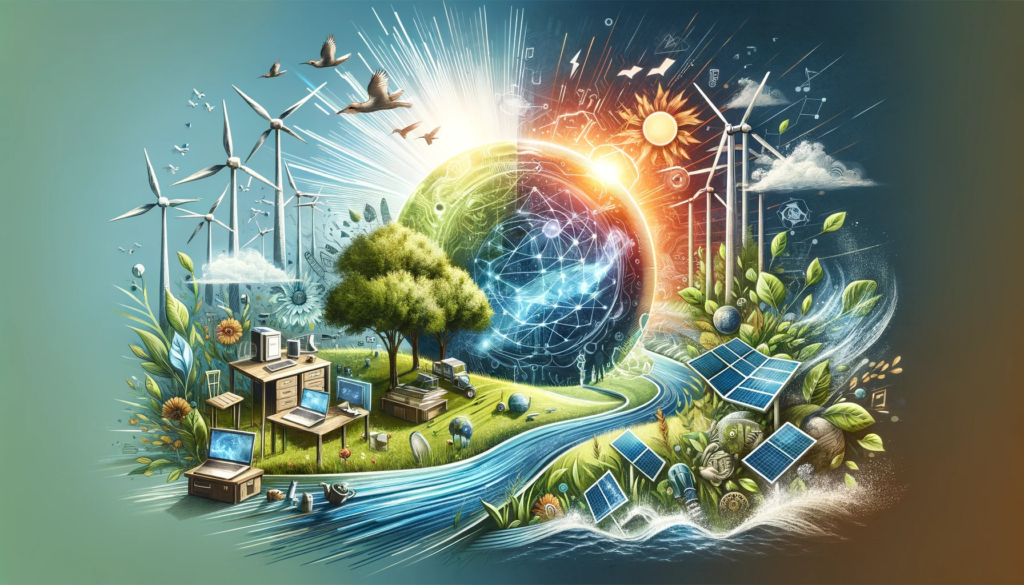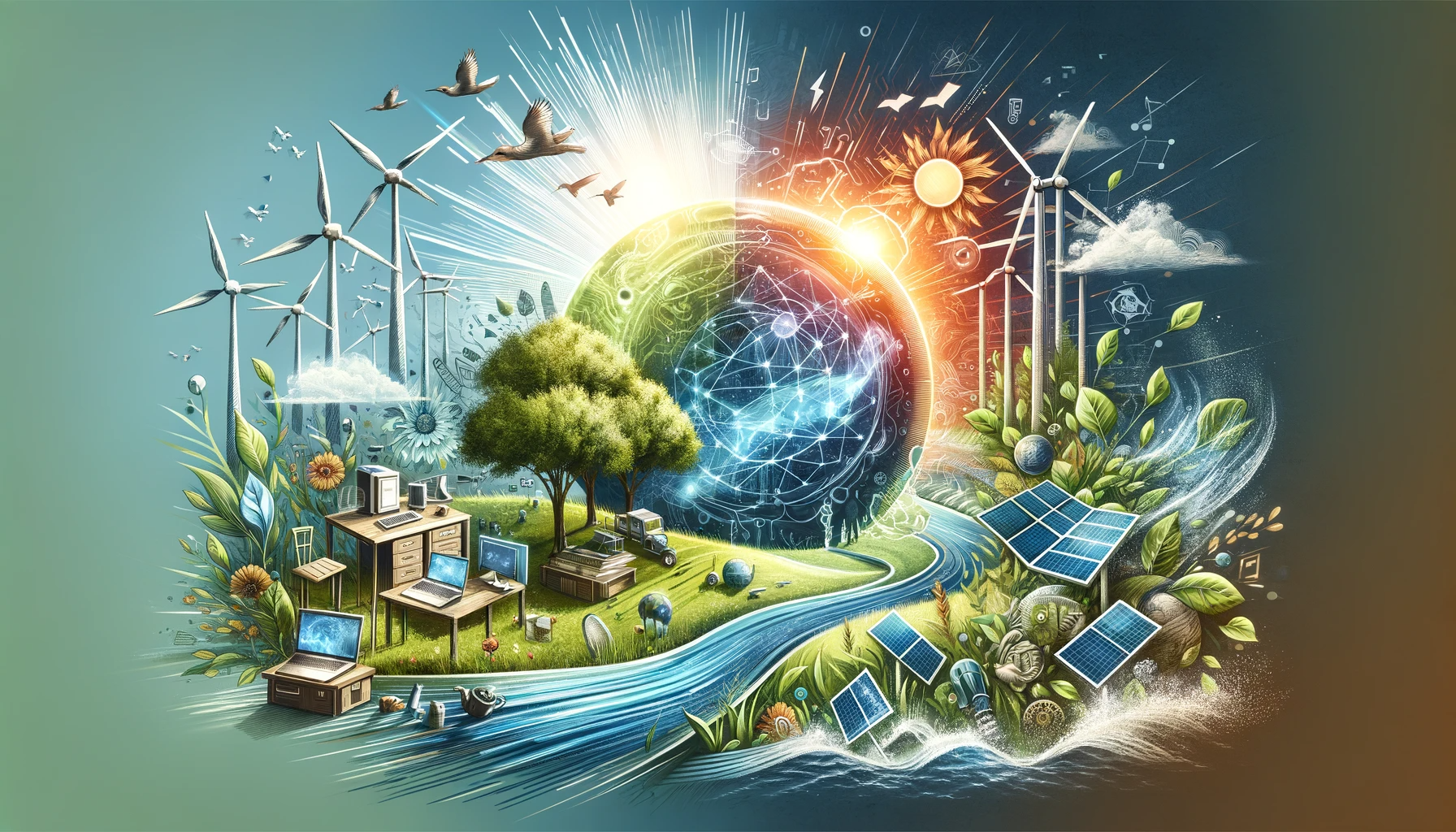Understanding the Concept of Sustainability in Today’s World
In the age of rapid technological advancement, it is crucial to understand the concept of sustainability and its relevance in today’s world. Sustainability refers to the ability to sustain or support an activity or process over a long period. It has three primary pillars: economic, social, and environmental, often dubbed as profits, people, and planet respectively. The goal is to create a balance among these three aspects without compromising any of them. This balance ensures that resources are used in such a way that both current and future generations can benefit. As we navigate through the 21st century, the importance of sustainability has been brought to light on a global scale due to various challenges such as climate change, poverty, inequality, and loss of biodiversity. These problems indicate an imbalance among the three pillars of sustainability. For instance, excessive emphasis on economic growth (profits) often leads to social inequalities (people) and environmental degradation (planet). Thus, making sustainable development not just desirable but imperative for our survival. To achieve sustainable development goals does not mean halting progress; rather it calls for redefining progress within sustainable limits. Technology plays a pivotal role in this transition by providing innovative solutions for efficient resource use while reducing environmental impact. Harnessing technology effectively can enable us to make substantial strides towards achieving sustainability without compromising our living standards or economic growth. Therefore, understanding how technology can promote sustainable development is vital in our quest for a balanced and prosperous future.

The Importance of Technology in Promoting Environmental Stewardship
The role of technology in promoting environmental stewardship is paramount. Technological advancements create opportunities for smarter and eco-friendly practices that lessen our impact on the environment. For instance, advancements in renewable energy technologies such as solar, wind, and hydroelectric power have greatly reduced our reliance on fossil fuels. These renewable sources provide cleaner energy that produces significantly less greenhouse gas emissions, thereby reducing our carbon footprint. Moreover, technology enables efficient energy use; smart grids and meters allow for better management of electricity consumption at a household or industrial level. In the realm of waste management, technology has ushered in innovative solutions to curb the detrimental effects of waste on our planet. Developments like recycling technologies have made it possible to recover and reuse materials that would otherwise end up in landfills. Also, digital platforms are being used to promote circular economy models where waste is viewed as a resource rather than a problem. This shift not only reduces pressure on natural resources but also opens up new economic opportunities. Similarly, technology plays an instrumental role in conservation efforts by providing tools for monitoring and protecting biodiversity. Satellite imagery and drones are used extensively for habitat surveillance and tracking wildlife populations, helping conservationists make informed decisions about species protection strategies. 3D printing technologies are even being employed to recreate damaged coral reefs – a crucial component of marine ecosystems under threat due to climate change and destructive human activities. Thus, while we may not be able to completely halt environmental degradation caused by past actions, technological innovations offer us opportunities to mitigate further damage and restore ecological balance.
Leveraging Digital Innovations for Efficient Resource Management
The rapid evolution of digital innovations has opened up a new frontier in resource management. In particular, the Internet of Things (IoT), artificial intelligence (AI), and blockchain technology stand out as powerful tools for efficient resource use and sustainable development. Through IoT devices, detailed data can be gathered in real-time across various sectors such as agriculture, water, energy, and waste management. This data-driven approach enables precise monitoring and control of resources, thereby eliminating wastage and enhancing sustainability. For example, IoT applications in agriculture – sometimes referred to as “smart farming” – allow farmers to monitor soil moisture levels in real-time, ensuring that crops receive the exact amount of water they need. In addition to IoT, AI is another technological marvel transforming resource management. Machine learning algorithms can analyze vast amounts of data gathered by IoT devices to detect patterns, make predictions, and provide actionable insights for decision-making. For instance, AI models can predict weather patterns with high accuracy which can help farmers plan their planting schedules effectively thereby reducing crop loss due to unfavorable weather conditions. Moreover, AI-driven predictive maintenance can minimize downtime in industries by identifying potential equipment failures before they occur thus improving efficiency and saving resources. Blockchain technology also holds enormous potential for promoting sustainable practices through its inherent transparency and traceability features. It provides a secure platform where all transactions are recorded chronologically making it impossible to tamper with the information once it’s recorded. This feature could revolutionize supply chain management by ensuring accountability at each stage of the production process. For instance, consumers could verify if products have been sourced ethically or if companies are complying with environmental standards set by regulatory authorities. While these technologies are still evolving and their full potential yet to be realized, they offer promising solutions that could significantly advance our efforts towards achieving sustainable development goals.
The Intersection of Green Technologies and Economic Growth
The advent of green technologies has set the stage for a new era of sustainable economic growth. A critical aspect of these technologies – including renewable energy, electric vehicles, and energy-efficient appliances – is that they not only mitigate environmental impact but can also spur economic development. According to the International Renewable Energy Agency (IRENA), renewable energy alone could add more than $1.7 trillion to the global economy by 2030. This potential for economic growth stems from numerous factors such as job creation in manufacturing and installation of green technologies, reduction in healthcare costs due to improved air quality, and increased resilience against volatile fossil fuel prices. The transition towards a green economy also presents an opportunity to address social inequalities through inclusive growth strategies. For instance, investing in renewable energy projects in rural or marginalized communities can provide stable employment opportunities while improving access to clean and affordable power. Similarly, promoting energy-efficient public transportation systems can reduce commuting costs for low-income households while curtailing urban air pollution. However, harnessing the full potential of green technologies for sustainable economic growth requires strategic policy interventions and robust institutional support. Policymakers need to establish conducive regulatory frameworks that incentivize the adoption of these technologies and de-risk investments in this sector. Public-private partnerships should be encouraged to drive innovation and scale up production of green technologies which will lower their costs over time making them more accessible to consumers at large. While there are challenges ahead, the alignment between green technology deployment and sustainable economic development offers a promising pathway towards achieving our shared vision for a greener and more equitable future.
Role of Renewable Energy Technologies in Reducing Carbon Footprint
Renewable energy technologies are at the forefront of efforts to reduce carbon footprints and facilitate sustainable development. These technologies, including solar panels, wind turbines, hydropower plants, and bioenergy systems, produce electricity without releasing harmful greenhouse gases that contribute to global warming. Moreover, they harness naturally replenishing resources such as sunlight, wind, water flow, and organic waste which makes them a more sustainable choice compared to traditional fossil fuels. With rapid advancements in technology over the past decades, renewables have become increasingly efficient and cost-competitive thus bolstering their adoption across sectors. In the journey towards decarbonization, renewable energy technologies play a critical role not only on an industrial scale but also at a community level. For instance, rooftop solar panels and small-scale wind turbines allow homes and local businesses to generate their own clean power. This decentralization of energy production can lead to significant reductions in carbon emissions while also providing energy security and cost savings for consumers. Furthermore, with innovative solutions such as smart grids and energy storage systems, communities can better manage their renewable power generation ensuring reliable supply even when the sun isn’t shining or the wind isn’t blowing. While it’s clear that renewable energy technologies are pivotal in reducing carbon footprints and driving sustainability , there is still much work to be done. Continued research and development is essential to improve efficiency levels and bring down costs further. In addition to technological advancements, supportive policy measures are needed to stimulate investment in renewables and accelerate their integration into our energy systems. From incentivizing green innovation through tax credits or subsidies to implementing renewable portfolio standards that mandate a certain percentage of power comes from renewables – these policy tools can significantly boost the deployment of green technologies thus facilitating our transition towards a low-carbon future.
How Information and Communications Technology (ICT) Contributes to Social Equity
Information and Communications Technology (ICT) is increasingly playing a pivotal role in promoting social equity across the globe. By connecting people, communities, and institutions, ICT is helping break down barriers to information access – a fundamental aspect of social equity. The internet, mobile technology, cloud-based services, social media platforms are some examples of ICT that can democratize access to knowledge and resources. These tools empower individuals with skills and opportunities that can help them improve their livelihoods and participate more actively in society. In the context of education, for instance, ICT has the potential to level the playing field by providing quality educational resources to those who may not have had access otherwise. Through online learning platforms and digital libraries, students from remote or economically disadvantaged areas can gain access to world-class education right at their fingertips. This equal distribution of educational opportunities is a significant step towards achieving social equity. Similarly, telemedicine technologies can bridge healthcare disparities by bringing medical services to remote or underserved populations. Moreover, ICT plays a crucial role in promoting transparency and accountability in governance which are key tenets of social equity. Digital platforms enable citizen participation in decision-making processes by providing an avenue for voicing concerns or suggestions directly to authorities. Moreover, through digital public services such as e-governance portals or mobile apps citizens can better monitor government activities fostering trust and cooperation between public officials and the populace they serve. Without overstating the point, it’s clear that ICT holds immense potential for advancing social equity. However, it’s worth noting that while technology acts as an enabler of equitable opportunities, its deployment should be done judiciously ensuring that it does not inadvertently widen existing socio-economic divides. Bridging the digital divide will therefore be instrumental in ensuring all members of society reap the benefits offered by these technological advancements.
Using Artificial Intelligence to Drive Sustainable Agricultural Practices
Artificial Intelligence (AI) is proving to be a game-changing technology in the realm of sustainable agriculture. It equips farmers with the tools they need to optimize their farming practices, thus enhancing productivity and sustainability concurrently. AI-powered systems can analyze large volumes of data from various sources such as weather patterns, soil conditions, crop health and more. Based on this information, AI can make informed predictions and decisions about optimal planting times, pest control methods, and irrigation schedules. This level of precision reduces waste and ensures that resources are utilized in a manner that aligns with sustainable development goals. Transitioning into another critical aspect of AI in agriculture, let’s delve into how it aids in risk mitigation. Agriculture is a sector fraught with uncertainties – unpredictable weather conditions, pests or plant diseases can wreak havoc on crops leading to significant losses for farmers. However, AI has the potential to significantly reduce these risks through predictive analytics. For instance, machine learning algorithms can identify patterns in historical weather data and predict future climate trends which helps farmers plan their sowing or harvesting activities accordingly. Similarly, image recognition technology can help detect early signs of pest infestations or plant diseases allowing for timely intervention. Further exemplifying the role of AI in sustainable agriculture is its contribution to reducing food waste – a pressing global issue that exacerbates environmental problems and economic loss. Technologies like machine vision combined with machine learning help sort harvested produce based on quality parameters quickly and accurately than manual sorting processes could achieve. This not only increases efficiency but also reduces wastage by ensuring only suitable produce makes it to market shelves while unsuitable ones are redirected towards composting or animal feed before they become unfit for any use. Therefore, through varied applications across the agricultural value chain – from field to market – AI stands at the forefront of driving sustainable agricultural practices.
The Impact of Smart City Technologies on Urban Living Standards
The advent of smart city technologies has brought significant advancements in urban living standards. From managing traffic congestion to reducing environmental pollution, these technologies are reshaping the way we live and interact with our environment. At the heart of this transformation is the Internet of Things (IoT), a network of connected devices that collect and share data. The IoT provides the backbone for various smart city applications, enhancing operational efficiency, improving public services, and making cities more sustainable. An excellent example of this is intelligent traffic management systems that leverage real-time data to optimize traffic flow and reduce congestion. Sensors embedded in roads or mounted on traffic lights gather information about vehicle numbers, speed, and route usage. This data is then processed by AI algorithms to predict traffic patterns and adjust signal timings accordingly. In doing so, these systems not only make commuting faster and less stressful for citizens but also contribute to lower fuel consumption and reduced emissions. Moreover, smart grids play an essential role in promoting energy efficiency- another key aspect of sustainable urban living. These systems use digital technology to monitor electricity usage in real-time, allowing utilities to better match supply with demand. They can also automate tasks like meter reading and fault detection which ultimately leads to cost savings for both utility companies and consumers. Additionally, by facilitating better integration of renewable energy sources into the grid, they play a crucial role in reducing carbon footprints. Aside from this, smart city technologies have introduced innovative solutions for waste management – a persistent challenge in urban areas due to growing populations and limited resources. Smart waste bins equipped with sensors notify sanitation departments when they are full thus eliminating unnecessary collection trips when bins are still empty while ensuring timely pickups when they reach capacity. This optimizes waste collection routes saving time, money and fuel while minimizing overflow issues that can lead to unsanitary conditions. In essence, through multiple facets like intelligent transport systems, smart grids or enhanced waste management solutions; smart city technologies significantly improve urban living standards while promoting sustainability.
Exploring Technological Solutions for Water Conservation Efforts
The advent of technology has provided us with innovative solutions to combat water scarcity, a pressing global issue. A prominent example is the use of smart meters and sensors in water management systems. These devices monitor water usage in real time, providing valuable data that can be used to identify leaks or excessive consumption. Users are alerted about any irregularities promptly, allowing for quick action. This not only helps conserve water but also results in significant cost savings for consumers. Transitioning into another aspect of tech-aided conservation efforts, we find the role of satellite imagery and remote sensing technology invaluable. These technologies are increasingly being used to map and monitor water resources on a large scale. Sophisticated algorithms analyze this data to assess the health of watersheds, predict future water availability, and plan efficient allocation strategies accordingly. In addition, these technologies can also monitor changes in land use or climate patterns that might affect water security. This information is vital for policy-makers and stakeholders involved in planning sustainable water management strategies at regional or national levels. Shifting focus towards another promising technological innovation – Artificial Intelligence (AI) has shown immense potential for optimizing irrigation practices in agriculture, which accounts for around 70% of world’s freshwater use. AI-powered systems can process vast amounts of data from weather forecasts, soil conditions and crop types to determine the optimal amount of water required for irrigation. By improving precision irrigation techniques, these systems not only reduce wastage but also increase crop yields and maintain soil health. Therefore, it’s clear that advancements like smart meters, satellite imaging or AI-backed irrigation systems offer effective technological solutions for enhancing our water conservation efforts without compromising productivity or living standards.
Future Trends: Next-Gen Tech Tools for a Greener Planet
Looking ahead, we can see a plethora of opportunities where technology will continue to drive sustainable development. One such exciting trend is the rise of the Internet of Things (IoT) in managing energy consumption. IoT-enabled devices in homes and industries can monitor and regulate energy use efficiently. For example, smart thermostats can learn our daily routines and adjust heating or cooling accordingly, reducing unnecessary energy waste. Likewise, IoT in industrial settings allows for real-time monitoring and optimization of machinery performance, leading to significant energy savings. Transitioning from IoT, let’s explore another promising tech tool – renewable energy storage technologies. While renewable sources like solar or wind are an excellent alternative to fossil fuels, their intermittent nature poses a challenge. That’s where innovative storage solutions come into play. Improved battery technologies like lithium-ion batteries have increased capacity and efficiency for storing power generated from renewables. Furthermore, advancements in hydrogen fuel cells offer another viable option for storing excess energy generated during peak production periods which can be used later when demand exceeds supply. Shifting gears towards green transportation trends, electric vehicles (EVs) represent another technological breakthrough promoting sustainability. Improved battery technology is making EVs increasingly affordable while also extending their range. In addition, the development of fast-charging infrastructure is solving challenges related to charging time and availability of charging stations. Moreover, autonomous driving technology integrated with EVs could further enhance their efficiency by optimizing route planning and reducing traffic congestion. Henceforth, these next-gen tech tools such as IoT for energy management, advanced storage systems for renewables and electric vehicles are set to shape a greener future for our planet.

